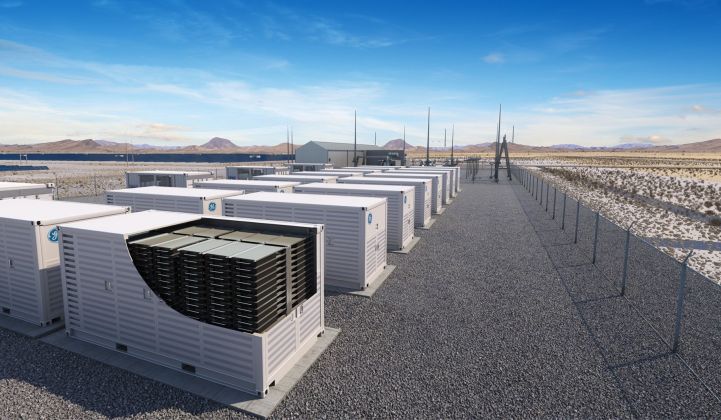GE won its biggest grid battery deal so far, to supply a solar plant in South Australia.
The 200-megawatt Solar River plant will be coupled with a 100-megawatt/300-megawatt-hour GE Reservoir grid storage system. Solar River already secured Crown Development Approval, and could start generating power as early as 2021.
This battery will outrank South Australia's Hornsdale Power Reserve, the Tesla-supplied system that currently holds the title for world's largest, but won't for long. Like that battery, it will provide fast-reacting capacity for a state grid dealing with rapid renewables growth and baseload coal retirement. But the GE system will use its longer energy duration to turn solar power into a dispatchable resource.
The project answers a warning that the Australian power market operator issued in a November report on the status of South Australia's grid.
"System strength needs to be more actively managed, and there is increased need for fast-start and rapid-response technologies to accommodate changes in renewable energy output and improve power system security," it said. "The shape of operational demand is becoming increasingly peaky, and both demand and supply are exposed to the vagaries of weather, changing the nature and profile of supply scarcity risks."
Rooftop solar provides 15 percent of South Australia's installed capacity; wind delivers 29 percent. Renewables account for nearly half of electricity generated, meaning the grid has considerable exposure to intermittent resources.
That exposure will continue to grow, as renewables constitute a majority of new capacity investments. Negative demand could arrive during peak solar production hours by 2023 or 2024, and rooftop solar has already pushed the daily peak later into the evening, when solar generation drops off.
Pairing the large solar plant with a battery, then, directly tackles the "vagaries of weather" issue.
The storage system at Solar River, among the largest proposed worldwide, will reduce the flood of additional solar generation in the middle of the day and make it available in the more valuable evening hours. Australia's competitive energy market rewards plant owners for arbitraging energy from times of surplus supply to times of scarcity.
The Australia market offers one of the fastest-growing opportunities for hybrid generation, said Gianpaolo Giuliani, energy storage global sales director at GE's Renewable Hybrids unit.
“The system is leveraging GE’s Reservoir technology, with a high energy density modular architecture, proprietary string-level battery control, and a hybrid controller which leverages our vast history of controls experience to appropriately orchestrate the solar dispatch and the battery storage output,” he added.
The deal marks a long-awaited validation for GE's energy storage program, which has been notable for its many permutations.
The industrial giant first competed in battery manufacturing, investing $170 million in a plant to build its sodium-ion Durathon batteries. But it wound down that operation in 2015 when the energy storage market proved slow to develop.
After that, GE moved energy storage to Current, its internal "startup" focused on commercial energy management. Current's many disparate offerings proved difficult to balance, and GE restructured it in 2016, pulling out storage and prioritizing efficient lighting.
GTM reported in early 2018 that GE had relocated its storage personnel to a standalone business unit within the flagship Power division. The unit received dedicated funding for global energy storage business development and sold 120 megawatt-hours in 2017. Gas turbine revenue dominated GE Power, and GE pitched battery storage as a useful complement to conventional gas plants, extending their life and letting them operate more efficiently.
Shortly thereafter, GE launched Reservoir, a containerized, 1.2-megawatt/4-megawatt-hour battery product. It shipped fully loaded with cells which could then be energized onsite; executives said this would cut system installation times in half compared to the usual practice of loading in the batteries onsite.
The old gas power business has been hurting, due to demand destruction from the global uptake of renewables, a trend which battery storage could accelerate. GE responded to that tension in January by splitting Gas Power into its own business and pulling energy storage into Renewable Energy, alongside wind, solar and hydro.
GE has revealed only a few Reservoir deals to date, including a couple of solar-paired systems in upstate New York and a gas turbine hybrid in the Los Angeles Basin. The Solar River deal marks the company's first confirmed foray into large-scale renewables storage.




